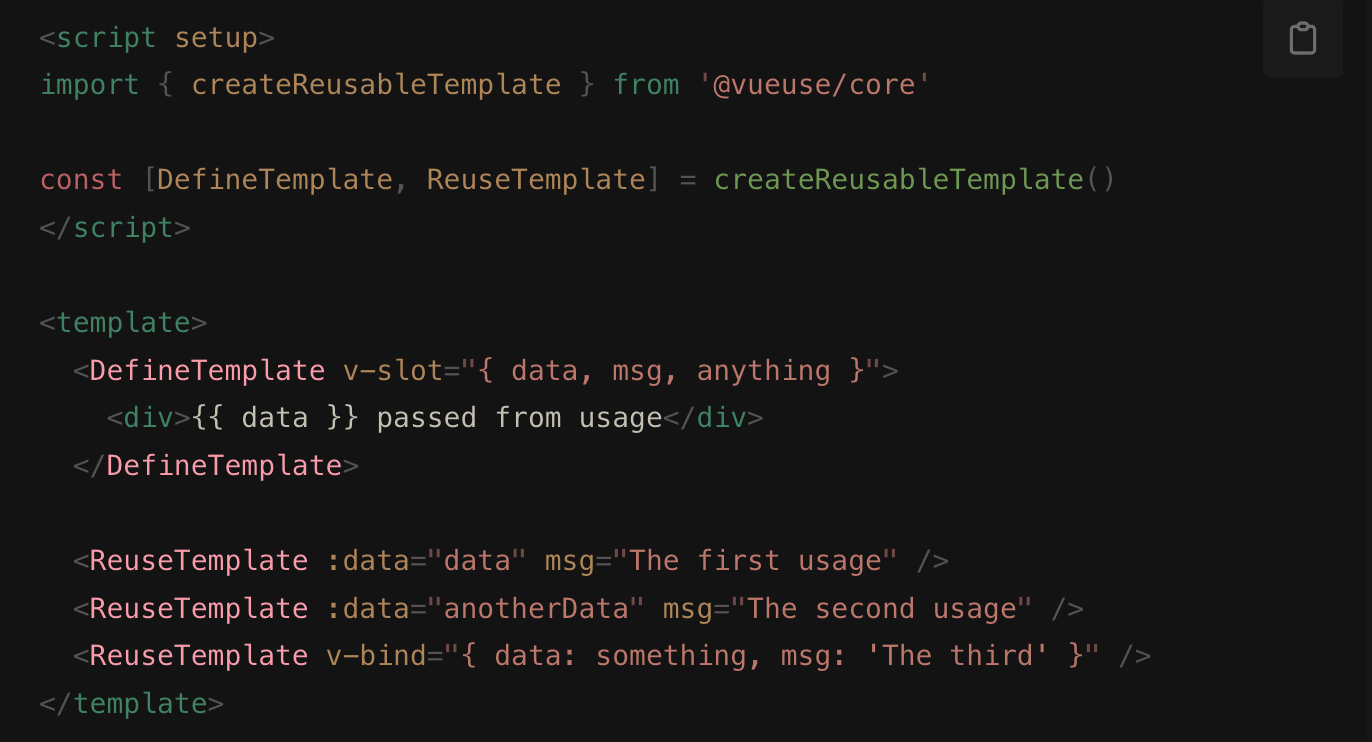在绝大多数情况下,Vue 推荐使用模板语法来创建应用。
先思考一下,你平时在 Vue 中是如何写模板代码的?
在业务场景下,我会优先选择 template 语法,因为更加直观和易读。template 中 html 代码一把梭,除非遇到可复用的组件或代码量比较大的组件,会选择封装成一个组件引入。
而对于 JSX 语法,只有在极少数 template 实在不好解决的情况下才会使用,其余 99% 的场景下都会使用 template 语法。
何时使用 JSX 语法
JSX 的本质是 createVNode,h()函数的内部执行的也是 createVNode 来生成虚拟 DOM 的,但是由于h()函数比较难写,所以我们使用 JSX 来更加方便快捷的书写。
之前我们提过在绝大多(99%)情况下,Vue 推荐使用模板语法来创建应用。那么另外的 1% 使用 JSX 的情况都有哪些?
我们来看几个例子:
案例 1
一个巨典型的例子,通过 level prop 动态生成标题的组件时,你可能很快想到这样实现:
<template>
<h1 v-if="level === 1">
<slot></slot>
</h1>
<h2 v-else-if="level === 2">
<slot></slot>
</h2>
<h3 v-else-if="level === 3">
<slot></slot>
</h3>
</template>
<script setup>
defineProps<
level: number
>()
</script>
这里用 template 模板并不是最好的选择,在每一个级别的标题中重复书写了部分代码,不够简洁优雅。如果尝试用 JSX 来写,代码就会变得简单很多:
const LevelHeading = () => {
const tag = `h${this.level}`
return <tag>{this.$slots.default}</tag>
}
案例 2
如果有这样一个场景:template 模板中包含很小并且重复的代码片段(不适合用 v-for 处理的代码),因为没有可复用性,并且代码量较少,抽出来单独封装一个组件反而代码量更大了,这种情况该如何处理呢 🧐?
React 中处理
如果你刚好有接触过 React 代码,那么你很快就能想到在 React 可以在一个函数式组件内声明对应的小组件,在函数式组件中可以这样写:
const App: FC = () => {
return (
<>
<Demo msg="msg1" />
这里是个隔断,没法循环
<Demo msg="msg2" />
</>
)
}
const Demo: FC<{ msg: string }> = ({ msg }) => {
return <div>demo msg is {msg} </div>
}
但在 Vue 中没法直接像 React 一样在单文件中声明其他组件,如果想复用代码,只能通过抽离封装组件的方式。
可是这么点代码我还封装个组件,创建文件再引入的工作量可比我直接 CV 大多了 😝。
那有没有什么办法可以让 Vue 中也可以声明其他组件呢? 且看下面这个案例。
Vue 组件中定义组件
 上图是我在需求中实现的一个具体案例,要求搜索的时候两边同时高亮展示搜索到的内容,先看下使用 template 语法的代码:
上图是我在需求中实现的一个具体案例,要求搜索的时候两边同时高亮展示搜索到的内容,先看下使用 template 语法的代码:
template 语法实现
<template>
<section class="memo-list__content-item">
<!-- 概要 -->
<section class="item-title">
<!-- 搜索内容超出概要可展示字符长度时前面展示... -->
<span v-if="searchIndex > CONTENT_CUT_LENGTH"
>{{searchIndex - 4 ? <span>...</span> : ''}}</span
>
<span>{{ content.slice(searchIndex - 4, searchIndex) }}</span>
<!-- 高亮展示搜索结果 -->
<span style="background: #fae086">{{
content.slice(searchIndex, searchValue.length + searchIndex)
}}</span>
<span>{{ content.slice(searchValue.length + searchIndex) }}</span>
</section>
<!-- 内容 -->
<section class="item-content">
<span>{{ content.slice(0, searchIndex) }}</span>
<!-- 高亮展示搜索结果 -->
<span style="background: #fae086">{{
content.slice(searchIndex, searchValue.length + searchIndex)
}}</span>
<span>{{ content.slice(searchValue.length + searchIndex) }}</span>
</section>
</section>
</template>
<script setup>
import { computed } from 'vue'
const searchIndex = computed(() => props.searchValue.indexOf(searchValue))
</script>
通过上面的代码,我们可以看到在对搜索内容进行 slice 截断处理,以展示搜索结果时,概要和内容区域做了重复性工作,而且这部分代码抽离再封装组件也不实际,要是能像 React 那样组件中再定义小组件就好了。
这时候就可以利用 JSX 来优化这部分代码。
Vue 与 React 中 JSX 语法的不同:
- React 定义类名使用 className,而 Vue 中直接使用 class 即可;
- Vue 中插槽的传递passing-slots等价于 React 中的 props.children + renderProps;
- ...
使用defineComponent搭配 JSX 创建小组件
defineComponent 搭配 Composition API 和渲染函数一起使用,接收 props 和 setup 上下文,返回值是一个渲染函数(h()或者 JSX)。
<template>
<section class="memo-list__content-item">
<!-- 概要 -->
<section class="item-title"><SearchContent :searchValue="searchValue" :content="item.title" /></section>
<!-- 内容 -->
<section class="item-content"><SearchContent :searchValue="searchValue" :content="item.content" /></section>
</section>
</template>
<script setup lang="tsx">
// 使用JSX创建组件
const SearchContent = defineComponent({
name: 'SearchContent',
props: {
searchValue: {
type: String,
default: ''
},
content: {
type: String,
default: ''
}
},
setup(props) {
const searchValue = props.searchValue
const content = props.content
const index = content.indexOf(searchValue)
if (index === -1) return content
const searchIndex = searchValue.length + index
// 搜索结果
const extraContent = startIndex => (
<>
{startIndex ? <span>...</span> : ''}
<span>{content.slice(startIndex, index)}</span>
<span style='background: #fae086'>{content.slice(index, searchIndex)}</span>
<span>{content.slice(searchIndex)}</span>
</>
)
if (searchIndex > CONTENT_CUT_LENGTH) return extraContent(index - 4)
return extraContent(0)
}
})
</script>
<script setup>中更简单的写法
在<script setup>中既可以像上面提到的使用defineComponent来定义子组件,也可以直接像 React 中那样定义子组件,即一个函数式组件,参考官方文档函数式组件一章,接收 props 和上下文对象,返回 JSX 或h()函数。
<template>
<!-- 概要 -->
<section class="item-title">
<RenderSearchContent :searchValue="searchValue" :content="item.title" />
</section>
<!-- 内容 -->
<section class="item-content">
<RenderSearchContent :searchValue="searchValue" :content="item.content" />
</section>
</template>
<script setup lang="tsx">
// 接收 props 和 setup上下文对象
const RenderSearchContent = ({ content = '', searchValue }) => {
const index = content.indexOf(searchValue)
if (index === -1) return content
const searchIndex = searchValue.length + index
// 搜索结果
const extraContent = (startIndex) => (
<>
{startIndex ? <span>...</span> : ''}
<span>{content.slice(startIndex, index)}</span>
<span style="background: #fae086">
{content.slice(index, searchIndex)}
</span>
<span>{content.slice(searchIndex)}</span>
</>
)
if (searchIndex > CONTENT_CUT_LENGTH) return extraContent(index - 4)
return extraContent(0)
}
</script>
这样比 defineComponent 简单,并且以函数式组件写的组件更符合我们平时的习惯,我推荐大家这样写,有宝马还要什么自行车呢。
createReusableTemplate
最近看到 antfu 大佬已经实现了在 .vue 模板中重复使用模板的钩子createReusableTemplate,大佬就是大佬,别人还在想的事情,他就实现了 🐮。有兴趣可以尝试尝试。

关于 createReusableTemplate 的由来可以看这个讨论:https://github.com/vuejs/core/discussions/6898
总结
本文从一个实际例子出发,讲述了如何利用 JSX 和函数式组件来优化我们的代码,了解了defineComponent和函数式组件在 Vue3 中的使用,可以尝试着去在项目里使用一下。但就如本文最开始提到的“在绝大多数情况下,Vue 推荐使用模板语法来创建应用”,如果有些实在觉得不好处理的再选择使用 JSX 去解决。
以上就是本文的全部内容,希望这篇文章对你有所帮助,欢迎点赞和收藏 🙏,如果发现有什么错误或者更好的解决方案及建议,欢迎随时联系。
京ICP备2022027737号
Copyright © 2022 - present @wangxiang